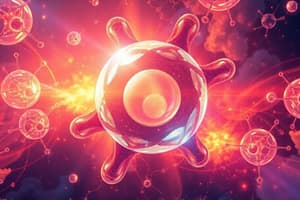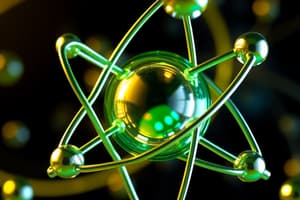Podcast
Questions and Answers
Which of the following best describes the relationship between a polymer and a plastic?
Which of the following best describes the relationship between a polymer and a plastic?
- Plastics and polymers are different names for the same class of substances.
- Plastics and polymers are completely unrelated substances.
- All polymers are plastics, but not all plastics are polymers.
- All plastics are polymers, but not all polymers are plastics. (correct)
Consider a sealed container containing only oxygen ($O_2$) molecules. If the temperature of the container is increased, what happens to the movement of individual oxygen atoms?
Consider a sealed container containing only oxygen ($O_2$) molecules. If the temperature of the container is increased, what happens to the movement of individual oxygen atoms?
- The oxygen atoms move faster because the molecules that they are apart of have more energy. (correct)
- The oxygen atoms stop moving completely.
- The atoms move slower because they have more energy.
- The atoms themselves do not move, only the molecules do.
If a scientist performs a 'pop test' and no 'pop' sound is heard, what can they conclude?
If a scientist performs a 'pop test' and no 'pop' sound is heard, what can they conclude?
- The gas produced is oxygen.
- The gas produced is carbon dioxide.
- The gas produced is not hydrogen. (correct)
- The gas produced is a noble gas.
In the context of solutions, how are the solute and solvent related?
In the context of solutions, how are the solute and solvent related?
Which of the following statements accurately contrasts non-metals with metals?
Which of the following statements accurately contrasts non-metals with metals?
Which characteristic primarily distinguishes an element from a compound?
Which characteristic primarily distinguishes an element from a compound?
Why did the organization of elements evolve over time?
Why did the organization of elements evolve over time?
What is the significance of the atomic number of an element?
What is the significance of the atomic number of an element?
How are elements arranged in the modern periodic table?
How are elements arranged in the modern periodic table?
What is the role of metalloids in the periodic table?
What is the role of metalloids in the periodic table?
Why are some elements represented by symbols that don't obviously relate to their English names, such as Na for sodium?
Why are some elements represented by symbols that don't obviously relate to their English names, such as Na for sodium?
How did Dalton's ideas advance Democritus's initial atomic concept?
How did Dalton's ideas advance Democritus's initial atomic concept?
If a newly discovered element is found to have similar chemical properties to Oxygen and Sulfur, in what part of the periodic table would it likely be located?
If a newly discovered element is found to have similar chemical properties to Oxygen and Sulfur, in what part of the periodic table would it likely be located?
Which of the following statements accurately distinguishes between compounds and mixtures?
Which of the following statements accurately distinguishes between compounds and mixtures?
If a scientist is trying to separate the elements from a compound, which method would be most suitable?
If a scientist is trying to separate the elements from a compound, which method would be most suitable?
Which of the following is a key difference between a homogeneous and heterogeneous mixture?
Which of the following is a key difference between a homogeneous and heterogeneous mixture?
What is the significance of a chemical formula like $H_2O$?
What is the significance of a chemical formula like $H_2O$?
Which of the following describes a substance that is 'ductile'?
Which of the following describes a substance that is 'ductile'?
What distinguishes an 'element' from a 'compound'?
What distinguishes an 'element' from a 'compound'?
Which of the following is an example of a chemical change that can separate elements from a compound?
Which of the following is an example of a chemical change that can separate elements from a compound?
Why is it impossible to write a chemical formula for a mixture?
Why is it impossible to write a chemical formula for a mixture?
What property is associated with a substance that is described as 'malleable'?
What property is associated with a substance that is described as 'malleable'?
Considering the properties of metals, non-metals, and metalloids, which statement is most accurate?
Considering the properties of metals, non-metals, and metalloids, which statement is most accurate?
Flashcards
Alchemists
Alchemists
Early scientists who attempted to manipulate matter, paving the way for modern chemistry.
Element
Element
A substance that cannot be broken down into simpler substances by chemical means, consisting of only one type of atom.
Atomic Number
Atomic Number
The number of protons found in the nucleus of an atom of a specific element. It uniquely identifies the element.
Protons
Protons
Signup and view all the flashcards
Neutrons
Neutrons
Signup and view all the flashcards
Electrons
Electrons
Signup and view all the flashcards
Periodic Table
Periodic Table
Signup and view all the flashcards
Compound
Compound
Signup and view all the flashcards
Molecule
Molecule
Signup and view all the flashcards
Noble Gases
Noble Gases
Signup and view all the flashcards
Photosynthesis
Photosynthesis
Signup and view all the flashcards
Solute
Solute
Signup and view all the flashcards
Mixture
Mixture
Signup and view all the flashcards
Chemical Symbol
Chemical Symbol
Signup and view all the flashcards
Chemical Formula
Chemical Formula
Signup and view all the flashcards
Atoms
Atoms
Signup and view all the flashcards
Bonded
Bonded
Signup and view all the flashcards
Aqueous
Aqueous
Signup and view all the flashcards
Malleable
Malleable
Signup and view all the flashcards
Lustre
Lustre
Signup and view all the flashcards
Study Notes
- Alchemists were early scientists that tried to manipulate matter
- The scientific method resulted in discoveries in the seventeenth century
- There are 92 naturally occurring elements
Elements
- An element is a substance composed of only one type of atom
- Element properties include color, texture, state at approximately 25°C, crystalline structure, luster, and surface
- Some elements can be dangerous, for example, sodium and mercury
Atomic Structure
- An atom contains a nucleus, which contains protons and neutrons
- Electrons move around the outside of the nucleus
- Protons have a positive charge
- Neutrons have no charge
- Electrons have a negative charge
- Protons and neutrons are similar in size
- Electrons are much smaller
- Each element has a unique atomic number, equal to the number of protons in its nucleus
- Elements have a chemical symbol, derived from their name, Greek or Latin name, for example, C, S, Na, K, Pb
Development of Atomic Theory
- Ideas about elements and atoms have evolved over time due to new scientific discoveries and technologies
- Democritus proposed atoms about 2500 years ago, further developed by Dalton in 1803
- Rutherford proposed the nuclear atom
- Joseph Thomson studied electrons, suggesting they existed in shells around the nucleus
- Early scientists organized elements based on their properties, leading to the periodic table
- Dmitri Mendeleev created the modern periodic table
- Elements are arranged by increasing atomic number in the periodic table
- Elements with similar properties are in vertical groups
- Elements are arranged in horizontal periods based on the number of electron shells in their atoms
- Most elements are metals, located on the left and center of the periodic table, separated from non-metals by metalloids
Compounds
- A compound is a substance made of two or more different types of atoms bonded together
- Elements are commonly found combined with other elements in compounds
- Compounds have varied uses
- Atoms in compounds are tightly bonded and can only be separated through chemical reactions
- Compound properties differ from the elements they contain
- Compounds have a definite amount of each element, for example, water has twice as many hydrogen atoms as oxygen atoms
- Mixtures have variable amounts of each element, so a chemical formula cannot be written for mixtures
- Elements can be separated from compounds through electricity, burning, or reactions with other substances
- A mixture is a combination of substances that retain their own properties
- Substances in a mixture are relatively easy to separate due to differing properties
- Atoms can bond in groups called molecules, for example, water (H2O) and carbon dioxide (CO2)
- The chemical formula shows the ratio of atoms of each element in the molecule
Key Terms
- Alchemist: An early chemist who tried to transmute metals into gold and predict the future
- Aqueous: A solution using water as the solvent
- Atomic number: The number of protons in an atom's nucleus, identifying the element
- Atoms: Small particles that make up all matter and have the same properties as the objects they compose
- Bonded: Joined by a force that holds particles together
- Brittle: Easily broken when hit
- Burning: Combining a substance with oxygen in a flame
- Cellular respiration: Chemical reactions transferring energy from molecules like glucose to ATP
- Chemical formula: Represents the ratio of atoms in a molecule or compound
- Chemical symbol: Abbreviation for elements, using one or two letters
- Colloid: A mixture where insoluble particles are dispersed and suspended in another substance
- Combustion: Combining with oxygen, commonly burning with a flame
- Compound: Substance made of two or more types of atoms chemically bonded together
- Decomposition: Breaking a substance into smaller parts
- Dissolved: When a solid integrates into a liquid solvent.
- Ductile: Can be drawn into wires
- Electrons: Light, negatively charged particles orbiting the nucleus
- Elements: Pure substances made of one type of atom
- Fossil fuel: Substance formed from ancient organisms, used as fuels for burning to produce heat
- Group: Vertical column of elements with similar properties in the periodic table
- Heterogeneous: Non-uniform composition throughout
- Homogeneous: Uniform composition throughout
- Hydrogen: Smallest atom and most common element in living things
- Inert: Not reactive
- Investigations: Activities aimed at finding information
- Lustre: High shine and sheen of a substance caused by the way it reflects light
- Malleable: Able to be bent or flattened into shape
- Metalloids: Elements with the appearance of metals but not all their properties
- Metals: Elements that conduct heat and electricity
- Mixture: Combination of substances retaining their individual properties
- Molecule: Two or more atoms joined together covalently
- Neutrons: Heavy, neutral particles in the nucleus
- Noble gases: Inert gases in the last column of the periodic table
- Non-metals: Elements that do not conduct electricity or heat
- Nucleus: Central part of an atom, made of protons and neutrons
- Observations: Information obtained through senses or instruments
- Oxygen: Atom that forms O2 molecules, essential for cellular respiration and a product of photosynthesis
- Periodic table: Table of elements grouped by properties and atomic number
- Photosynthesis: Chemical reactions in chloroplasts converting light energy into chemical energy
- Plastic: A synthetic substance capable of being moulded
- Polymer: A substance made by joining smaller identical units
- Pop test: A test that uses a flame to test for the presence of hydrogen
- Protons: Heavy, positively charged particles in the nucleus
- Scientists: People skilled in or working in the fields of science who use experiments to find out about the material world
- Solute: A dissolved substance in a solution
- Solvent: The substance in which the solute is dissolved
- Suspension: A mixture in which solid substances do not dissolve and are dispersed throughout the volume of the liquid
Studying That Suits You
Use AI to generate personalized quizzes and flashcards to suit your learning preferences.



